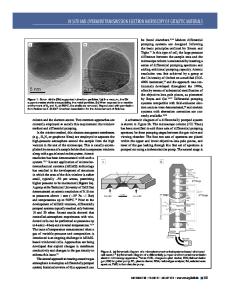In situ transmission electron microscopy investigation of threading dislocation motion in passivated thin aluminum films
- PDF / 313,725 Bytes
- 4 Pages / 612 x 792 pts (letter) Page_size
- 15 Downloads / 407 Views
MATERIALS RESEARCH
Welcome
Comments
Help
In situ transmission electron microscopy investigation of threading dislocation motion in passivated thin aluminum films R-M. Keller-Flaig Max-Planck-Institut fu¨r Metallforschung and Institut fu¨r Metallkunde der Universita¨t Stuttgart, Seestr. 71, D-70174 Stuttgart, Germany
M. Legros Laboratoire de Physique des Mate´riaux/CNRS—Ecole des Mines, Parc de Saurupt, 54042 Nancy Cedex, France
W. Sigle Max-Planck-Institut fu¨r Metallforschung Seestr., D-70174 Stuttgart, Germany
A. Gouldstone Department of Materials Science and Engineering, Massachusetts Institute of Technology, Cambridge, Massachusetts 02139
K.J. Hemker Department of Mechanical Engineering, Johns Hopkins University, Baltimore, Maryland 21218-2681
S. Suresh Department of Materials Science and Engineering, Massachusetts Institute of Technology, Cambridge, Massachusetts 02139
E. Arzt Max-Planck-Institut fu¨r Metallforschung and Institut fu¨r Metallkunde der Universita¨t Stuttgart, Seestr. 71, D-70174 Stuttgart, Germany (Received 7 December 1998; accepted 29 September 1999)
In situ transmission electron microscopy (TEM) was performed to study dislocation motion during temperature cycles in aluminum films passivated with a SiO2 layer. The films were cycled from room temperature to 450 °C. Wedge-shaped cross-sectional TEM samples were used to retain the constraint of the Si substrate. Besides interactions between dislocations and interfaces, the movement of threading dislocations within the constrained aluminum film was observed. This observation provides an experimental corroboration of the occurrence of threading dislocation motion, which is the basis for rationalizing the high-yield strength of thin films in available models of thin-film plasticity.
I. INTRODUCTION
It is well known that thin films deposited on substrates support much higher stresses than similar bulk samples of the same material. This result can be explained by the constraint on the motion of dislocations which have to “channel” through the film. Such a model was developed by Nix1 based on earlier theoretical considerations by Freund.2 It predicts that the yield stress of the thin film should be approximately proportional to the inverse film thickness. The model requires the presence and motion of “threading dislocations,” which extend through the thickness of the film. As they move, they leave interface dislocations at the interfaces between the film and the substrate, and between the film and the passivation layer. J. Mater. Res., Vol. 14, No. 12, Dec 1999
http://journals.cambridge.org
Downloaded: 16 Mar 2015
These predictions of the model are in at least qualitative agreement with many experimental investigations of the overall yield behavior of thin films.3–7 However, only little in situ transmission electron microscopy (TEM) information about the dislocation motion in a thin film is available. Most workers used plan view samples,8–11 however, only a cross-section through the layer package allows clear information about the interf
Data Loading...










